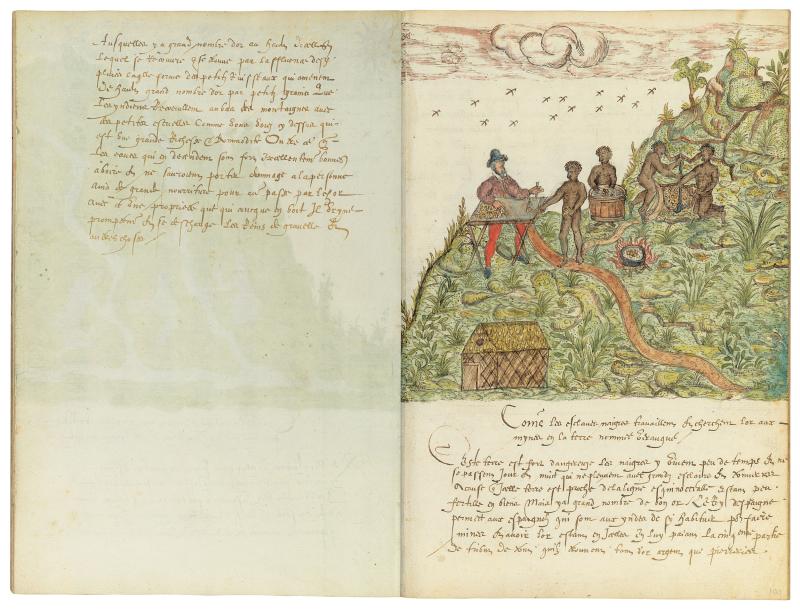
Histoire Naturelle des Indes
Illustrated manuscript
Bequest of Clara S. Peck, 1983
Continued from fol. 99
In these mountains there is up high a great quantity of gold which is recovered and found in the falling rain which forms small brooks carrying much gold in small grains from the heights which the Indians collect at the foot of the mountains in small bowls as you see here above. It represents great wealth and convenience beyond the fact that the water coming down from the mountains is extremely good for drinking and does not harm a person. It is even very nourishing for having passed through gold and has besides a particular virtue so that whoever drinks it urinates promptly and frees his kidneys of gravel and other things.
Come Les Esclaues Naigres Trauaillent Et Cherchent Lor Aux-Mynes En La Terre Nommee Veraugue (How the Negro Slaves Work and Look for Gold in the Mines of the Region Called Veragua [Panama])
This region is very dangerous. The negroes live there only a short time and no day and night passes without rain, lightning and thunder because this land is so close to the equinoctial line. Being not fertile in goods, it has however a great deal of good gold. The King of Spain permits the Spaniards in the Indies to settle to build mines and own the gold in them as long as they pay him the tribute of a fifth of everything they find, of gold, silver, as well as of precious stones.
In 1983, The Morgan Library & Museum received, as the bequest of Clara S. Peck, an extraordinary volume whose beautiful paintings and descriptions document the plant, animal, and human life of the Caribbean late in the sixteenth century. Spaniards had already begun to exert influence over the indigenous people of the area when explorers from England and France arrived, among them Sir Francis Drake. The volume, known as the Drake Manuscript and titled Histoire Naturelle des Indes when it was bound in the eighteenth century, gives us a wonderful picture of daily life at the time of Drake's many visits to the region. Although Drake's connection to the manuscript is uncertain, he is mentioned on more than one occasion by the authors. Drake himself is known to have painted, but none of his work survives.
Contents: 199 images of West Indian plants, animals and human life, with accompanying manuscript captions written in late sixteenth-century French.
Medium: Most of the illustrations consist of a black chalk underdrawing and a combination of pen and brown ink with watercolor; on some images selected areas have also been glazed with a gum.
Binding: Bound or rebound in brown leather in the late 18th century.
Pagination: Penciled folio numbers (1–125) in lower right corner of each page were added by The Morgan Library & Museum. Folios 92v–93, 93v–94, and 95v–96 are fold-out leaves.
